The NVIDIA GeForce RTX 2080 Ti & RTX 2080 Founders Edition Review: Foundations For A Ray Traced Future
by Nate Oh on September 19, 2018 5:15 PM EST- Posted in
- GPUs
- Raytrace
- GeForce
- NVIDIA
- DirectX Raytracing
- Turing
- GeForce RTX
The RTX Recap: A Brief Overview of the Turing RTX Platform
Overall, NVIDIA’s grand vision for real-time, hybridized raytracing graphics means that they needed to make significant architectural investments into future GPUs. The very nature of the operations required for ray tracing means that they don’t map to traditional SIMT execution especially well, and while this doesn’t preclude GPU raytracing via traditional GPU compute, it does end up doing so relatively inefficiently. Which means that of the many architectural changes in Turing, a lot of them have gone into solving the raytracing problem – some of which exclusively so.
To that end, on the ray tracing front Turing introduces two new kinds of hardware units that were not present on its Pascal predecessor: RT cores and Tensor cores. The former is pretty much exactly what the name says on the tin, with RT cores accelerating the process of tracing rays, and all the new algorithms involved in that. Meanwhile the tensor cores are technically not related to the raytracing process itself, however they play a key part in making raytracing rendering viable, along with powering some other features being rolled out with the GeForce RTX series.
Starting with the RT cores, these are perhaps NVIDIA’s biggest innovation – efficient raytracing is a legitimately hard problem – however for that reason they’re also the piece of the puzzle that NVIDIA likes talking about the least. The company isn’t being entirely mum, thankfully. But we really only have a high level overview of what they do, with the secret sauce being very much secret. How NVIDIA ever solved the coherence problems that dog normal raytracing methods, they aren’t saying.
At a high level then, the RT cores can essentially be considered a fixed-function block that is designed specifically to accelerate Bounding Volume Hierarchy (BVH) searches. BVH is a tree-like structure used to store polygon information for raytracing, and it’s used here because it’s an innately efficient means of testing ray intersection. Specifically, by continuously subdividing a scene through ever-smaller bounding boxes, it becomes possible to identify the polygon(s) a ray intersects with in only a fraction of the time it would take to otherwise test all polygons.
NVIDIA’s RT cores then implement a hyper-optimized version of this process. What precisely that entails is NVIDIA’s secret sauce – in particular the how NVIDIA came to determine the best BVH variation for hardware acceleration – but in the end the RT cores are designed very specifically to accelerate this process. The end product is a collection of two distinct hardware blocks that constantly iterate through bounding box or polygon checks respectively to test intersection, to the tune of billions of rays per second and many times that number in individual tests. All told, NVIDIA claims that the fastest Turing parts, based on the TU102 GPU, can handle upwards of 10 billion ray intersections per second (10 GigaRays/second), ten-times what Pascal can do if it follows the same process using its shaders.
NVIDIA has not disclosed the size of an individual RT core, but they’re thought to be rather large. Turing implements just one RT core per SM, which means that even the massive TU102 GPU in the RTX 2080 Ti only has 72 of the units. Furthermore because the RT cores are part of the SM, they’re tightly couple to the SMs in terms of both performance and core counts. As NVIDIA scales down Turing for smaller GPUs by using a smaller number of SMs, the number of RT cores and resulting raytracing performance scale down with it as well. So NVIDIA always maintains the same ratio of SM resources (though chip designs can very elsewhere).
Along with developing a means to more efficiently test ray intersections, the other part of the formula for raytracing success in NVIDIA’s book is to eliminate as much of that work as possible. NVIDIA’s RT cores are comparatively fast, but even so, ray interaction testing is still moderately expensive. As a result, NVIDIA has turned to their tensor cores to carry them the rest of the way, allowing a moderate number of rays to still be sufficient for high-quality images.
In a nutshell, raytracing normally requires casting many rays from each and every pixel in a screen. This is necessary because it takes a large number of rays per pixel to generate the “clean” look of a fully rendered image. Conversely if you test too few rays, you end up with a “noisy” image where there’s significant discontinuity between pixels because there haven’t been enough rays casted to resolve the finer details. But since NVIDIA can’t actually test that many rays in real time, they’re doing the next-best thing and faking it, using neural networks to clean up an image and make it look more detailed than it actually is (or at least, started out at).
To do this, NVIDIA is tapping their tensor cores. These cores were first introduced in NVIDIA’s server-only Volta architecture, and can be thought of as a CUDA core on steroids. Fundamentally they’re just a much larger collection of ALUs inside a single core, with much of their flexibility stripped away. So instead of getting the highly flexible CUDA core, you end up with a massive matrix multiplication machine that is incredibly optimized for processing thousands of values at once (in what’s called a tensor operation). Turing’s tensor cores, in turn, double down on what Volta started by supporting newer, lower precision methods than the original that in certain cases can deliver even better performance while still offering sufficient accuracy.
As for how this applies to ray tracing, the strength of tensor cores is that tensor operations map extremely well to neural network inferencing. This means that NVIDIA can use the cores to run neural networks which will perform additional rendering tasks. in this case a neural network denoising filter is used to clean up the noisy raytraced image in a fraction of the time (and with a fraction of the resources) it would take to actually test the necessary number of rays.
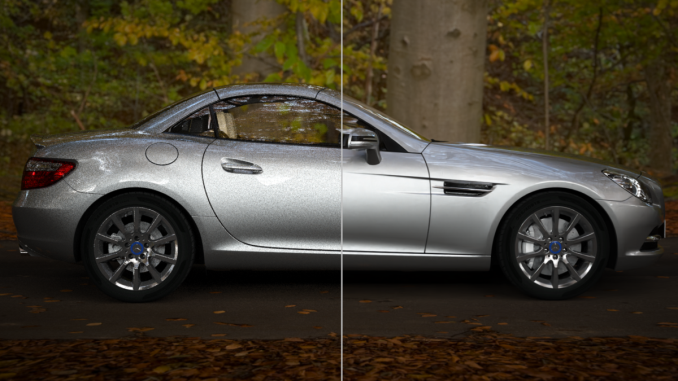
No Denoising vs. Denoising in Raytracing
The denoising filter itself is essentially an image resizing filter on steroids, and can (usually) produce a similar quality image as brute force ray tracing by algorithmically guessing what details should be present among the noise. However getting it to perform well means that it needs to be trained, and thus it’s not a generic solution. Rather developers need to take part in the process, training a neural network based on high quality fully rendered images from their game.
Overall there are 8 tensor cores in every SM, so like the RT cores, they are tightly coupled with NVIDIA’s individual processor blocks. Furthermore this means tensor performance scales down with smaller GPUs (smaller SM counts) very well. So NVIDIA always has the same ratio of tensor cores to RT cores to handle what the RT cores coarsely spit out.
Deep Learning Super Sampling (DLSS)
Now with all of that said, unlike the RT cores, the tensor cores are not fixed function hardware in a traditional sense. They’re quite rigid in their abilities, but they are programmable none the less. And for their part, NVIDIA wants to see just how many different fields/tasks that they can apply their extensive neural network and AI hardware to.
Games of course don’t fall under the umbrella of traditional neural network tasks, as these networks lean towards consuming and analyzing images rather than creating them. None the less, along with denoising the output of their RT cores, NVIDIA’s other big gaming use case for their tensor cores is what they’re calling Deep Learning Super Sampling (DLSS).
DLSS follows the same principle as denoising – how can post-processing be used to clean up an image – but rather than removing noise, it’s about restoring detail. Specifically, how to approximate the image quality benefits of anti-aliasing – itself a roundabout way of rendering at a higher resolution – without the high cost of actually doing the work. When all goes right, according to NVIDIA the result is an image comparable to an anti-aliased image without the high cost.
Under the hood, the way this works is up to the developers, in part because they’re deciding how much work they want to do with regular rendering versus DLSS upscaling. In the standard mode, DLSS renders at a lower input sample count – typically 2x less but may depend on the game – and then infers a result, which at target resolution is similar quality to a Temporal Anti-Aliasing (TAA) result. A DLSS 2X mode exists, where the input is rendered at the final target resolution and then combined with a larger DLSS network. TAA is arguably not a very high bar to set – it’s also a hack of sorts that seeks to avoid doing real overdrawing in favor of post-processing – however NVIDIA is setting out to resolve some of TAA’s traditional inadequacies with DLSS, particularly blurring.
Now it should be noted that DLSS has to be trained per-game; it isn’t a one-size-fits all solution. This is done in order to apply a unique neutral network that’s appropriate for the game at-hand. In this case the neural networks are trained using 64x SSAA images, giving the networks a very high quality baseline to work against.
None the less, of NVIDIA’s two major gaming use cases for the tensor cores, DLSS is by far the more easily implemented. Developers need only to do some basic work to add NVIDIA’s NGX API calls to a game – essentially adding DLSS as a post-processing stage – and NVIDIA will do the rest as far as neural network training is concerned. So DLSS support will be coming out of the gate very quickly, while raytracing (and especially meaningful raytracing) utilization will take much longer.
In sum, then the upcoming game support aligns with the following table.
| Planned NVIDIA Turing Feature Support for Games | |||||
| Game | Real Time Raytracing | Deep Learning Supersampling (DLSS) | Turing Advanced Shading | ||
| Ark: Survival Evolved | Yes | ||||
| Assetto Corsa Competizione | Yes | ||||
| Atomic Heart | Yes | Yes | |||
| Battlefield V | Yes | ||||
| Control | Yes | ||||
| Dauntless | Yes | ||||
| Darksiders III | Yes | ||||
| Deliver Us The Moon: Fortuna | Yes | ||||
| Enlisted | Yes | ||||
| Fear The Wolves | Yes | ||||
| Final Fantasy XV | Yes | ||||
| Fractured Lands | Yes | ||||
| Hellblade: Senua's Sacrifice | Yes | ||||
| Hitman 2 | Yes | ||||
| In Death | Yes | ||||
| Islands of Nyne | Yes | ||||
| Justice | Yes | Yes | |||
| JX3 | Yes | Yes | |||
| KINETIK | Yes | ||||
| MechWarrior 5: Mercenaries | Yes | Yes | |||
| Metro Exodus | Yes | ||||
| Outpost Zero | Yes | ||||
| Overkill's The Walking Dead | Yes | ||||
| PlayerUnknown Battlegrounds | Yes | ||||
| ProjectDH | Yes | ||||
| Remnant: From the Ashes | Yes | ||||
| SCUM | Yes | ||||
| Serious Sam 4: Planet Badass | Yes | ||||
| Shadow of the Tomb Raider | Yes | ||||
| Stormdivers | Yes | ||||
| The Forge Arena | Yes | ||||
| We Happy Few | Yes | ||||
| Wolfenstein II | Yes | ||||


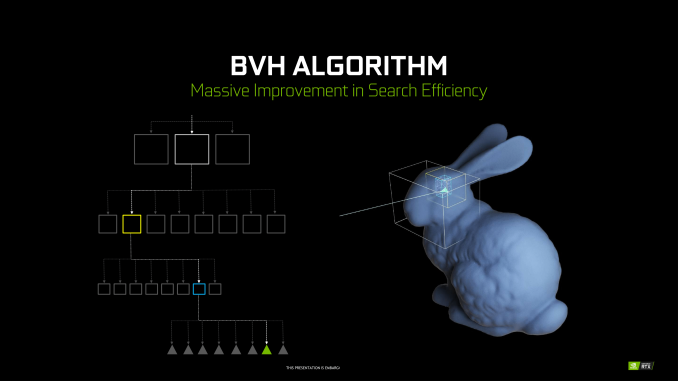
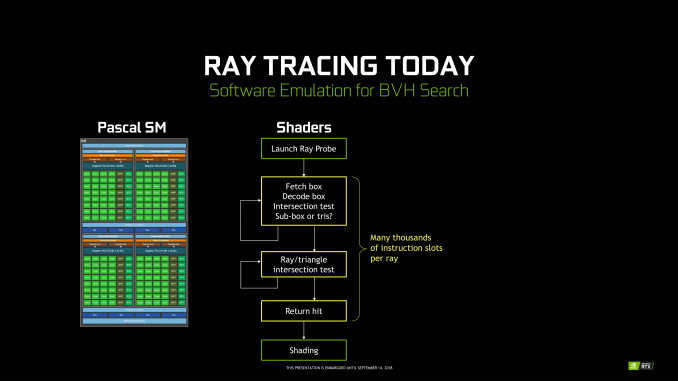
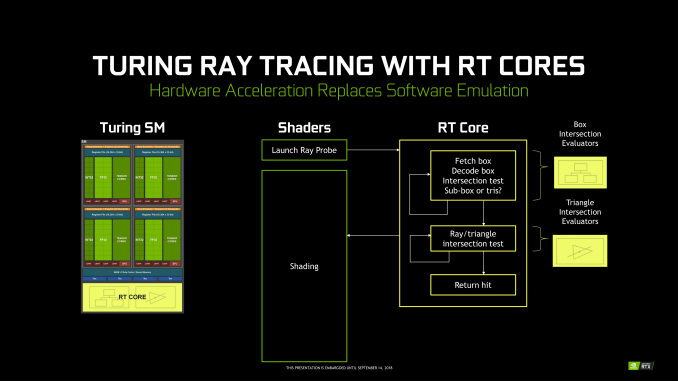
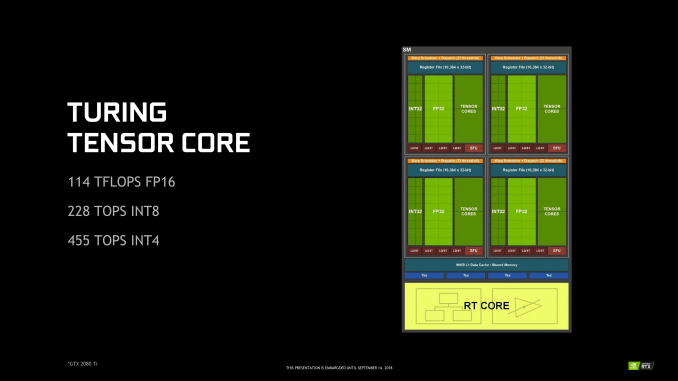
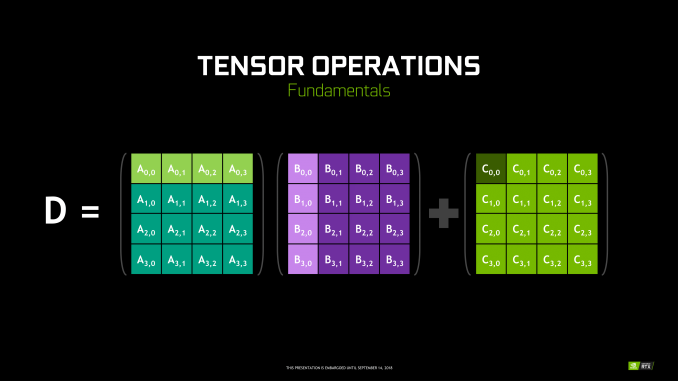
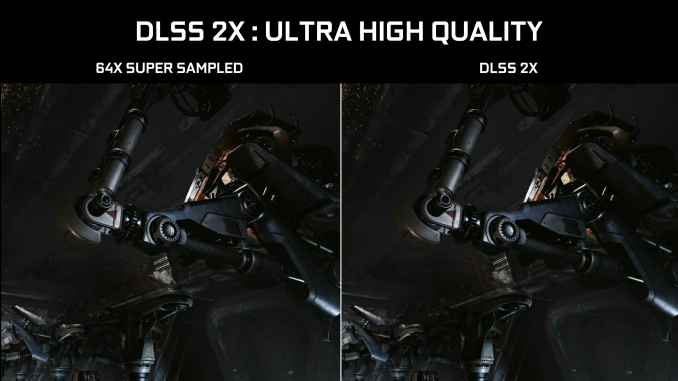








337 Comments
View All Comments
Hixbot - Friday, September 21, 2018 - link
I'm not sure how midrange 2070/2060 cards will sell if they're not a significant value in performance/price compared to 1070/1060 cards. If AMD offer no competition, Nvidia should still compete with itselfWwhat - Saturday, September 22, 2018 - link
It's interesting that every comment I've seen says a similar thing and that nobody thinks of uses outside of gaming.I would think that for real raytracers and Adobe's graphics and video software for instance the tensor and RT cores would be very interesting.
I wonder though if open source software will be able to successfully use that new hardware or that Nvidia is too closed for it to get the advantages you might expect.
And apart from raytracers and such there is also the software science students use too.
And with the interest in AI currently by students and developers it might also be an interesting offering.
Although that again relies on Nvidia playing ball a bit.
michaelrw - Wednesday, September 19, 2018 - link
"where paying 43% or 50% more gets you 27-28% more performance"1080 Ti can be bought in the $600 range, wheres the 2080 Ti is $1200 .. so I'd say thats more than 43-50% price increase..at a minimum we're talking a 71% increase, at worst 100% (Launch MSRP for 1080 Ti was $699)
V900 - Wednesday, September 19, 2018 - link
Which is the wrong way of looking at it.NVIDIA didn’t just increase the price for shit and giggles, the Turing GPUs are much more expensive to fab, since you’re talking about almost 20 BILLION transistors squeezed into a few hundred mm2.
Regardless: Comparing the 2080 with the 1080, and claiming there is a 70% price increase, is a bogus logic in the first place, since the 2080 brings a number of things to the table that the 1080 isn’t even capable of.
Find me a 1080ti with DLSS and that is also capable of raytracing, and then we can compare prices and figure out if there’s a price increase or not.
imaheadcase - Wednesday, September 19, 2018 - link
In brings it to the table..on paper more like it. You literally listed the two things that are not really shown AT ALL.mscsniperx - Wednesday, September 19, 2018 - link
No, actually YOUR logic is bogus. Find me a DLSS or Raytracing game to bench.. You can't. There is a reason for that. Raytracing will require a Massive FPS hit, Nvidia knows this and is delaying you from seeing that as damage control.Yojimbo - Wednesday, September 19, 2018 - link
There are no ray tracing games because the technology is new, not because NVIDIA is "delaying them". As far as DLSS, I think those games will appear faster than ray tracing.Andrew LB - Thursday, September 20, 2018 - link
Coming soon:Darksiders III from Gunfire Games / THQ Nordic
Deliver Us The Moon: Fortuna from KeokeN Interactive
Fear The Wolves from Vostok Games / Focus Home Interactive
Hellblade: Senua's Sacrifice from Ninja Theory
KINETIK from Hero Machine Studios
Outpost Zero from Symmetric Games / tinyBuild Games
Overkill's The Walking Dead from Overkill Software / Starbreeze Studios
SCUM from Gamepires / Devolver Digital
Stormdivers from Housemarque
Ark: Survival Evolved from Studio Wildcard
Atomic Heart from Mundfish
Dauntless from Phoenix Labs
Final Fantasy XV: Windows Edition from Square Enix
Fractured Lands from Unbroken Studios
Hitman 2 from IO Interactive / Warner Bros.
Islands of Nyne from Define Human Studios
Justice from NetEase
JX3 from Kingsoft
Mechwarrior 5: Mercenaries from Piranha Games
PlayerUnknown’s Battlegrounds from PUBG Corp.
Remnant: From The Ashes from Arc Games
Serious Sam 4: Planet Badass from Croteam / Devolver Digital
Shadow of the Tomb Raider from Square Enix / Eidos-Montréal / Crystal Dynamics / Nixxes
The Forge Arena from Freezing Raccoon Studios
We Happy Few from Compulsion Games / Gearbox
Funny how the same people who praised AMD for being the first to bring full DX12 support yet only 15 games in the first two years used it, are the same people sh*tting on nVidia for bringing a far more revolutionary technology that's going to be in far more games in a shorter time span.
jordanclock - Thursday, September 20, 2018 - link
Considering AMD was the first to bring support to an API that all GPUs could have support for, DLSS is not a comparison. DLSS is an Nvidia-only feature and Nvidia couldn't manage to have even ONE game on launch day with DLSS.Manch - Thursday, September 20, 2018 - link
AMD spawned Mantle which then turned into Vulcan. Also pushed MS to dev DX12 as it was in both their interests. These APIs can be used by all.DLSS while potentially very cool, is as Jordan said proprietary. Like hair works and other crap ot will get light support but devs when it comes to feature sets will spend most of their effort building to common ground. With consoles being AMD GPU based, guess where that will be.
If will be interesting how AMD will ultimatley respond. Ie gsync/freesync CUDA/OpenCL, etc.
As Nvidia has stated, these features are designed to work with how current game engines already function so they dont (the devs) have to reinvent the wheel. Ultimately this meanz the integration wont be very deep at least not for awhile.
For consumers the end goal is always better graphics at the same price point when new releases happen.
Not that these are bad cards, just expensove and two very key features are unavailable, and that sucks. Hopefully the situation will change sooner rather than later.